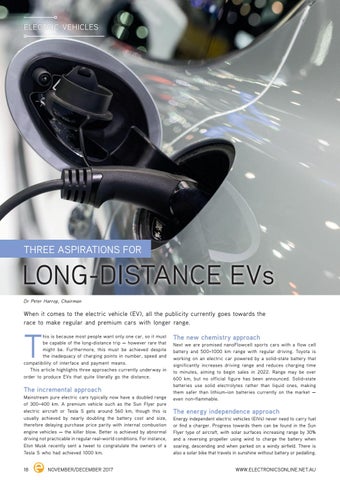ELECTRIC VEHICLES
THREE ASPIRATIONS FOR
LONG-DISTANCE EVs Dr Peter Harrop, Chairman
When it comes to the electric vehicle (EV), all the publicity currently goes towards the race to make regular and premium cars with longer range.
T
his is because most people want only one car, so it must be capable of the long-distance trip — however rare that might be. Furthermore, this must be achieved despite the inadequacy of charging points in number, speed and compatibility of interface and payment means. This article highlights three approaches currently underway in order to produce EVs that quite literally go the distance.
The incremental approach Mainstream pure electric cars typically now have a doubled range of 300–400 km. A premium vehicle such as the Sun Flyer pure electric aircraft or Tesla S gets around 560 km, though this is usually achieved by nearly doubling the battery cost and size, therefore delaying purchase price parity with internal combustion engine vehicles — the killer blow. Better is achieved by abnormal driving not practicable in regular real-world conditions. For instance, Elon Musk recently sent a tweet to congratulate the owners of a Tesla S who had achieved 1000 km.
18 NOVEMBER/DECEMBER 2017
The new chemistry approach Next we are promised nanoFlowcell sports cars with a flow cell battery and 500–1000 km range with regular driving. Toyota is working on an electric car powered by a solid-state battery that significantly increases driving range and reduces charging time to minutes, aiming to begin sales in 2022. Range may be over 600 km, but no official figure has been announced. Solid-state batteries use solid electrolytes rather than liquid ones, making them safer than lithium-ion batteries currently on the market — even non-flammable.
The energy independence approach Energy independent electric vehicles (EIVs) never need to carry fuel or find a charger. Progress towards them can be found in the Sun Flyer type of aircraft, with solar surfaces increasing range by 30% and a reversing propeller using wind to charge the battery when soaring, descending and when parked on a windy airfield. There is also a solar bike that travels in sunshine without battery or pedalling.
WWW.ELECTRONICSONLINE.NET.AU
